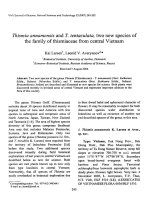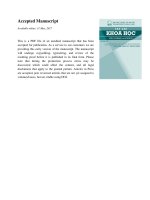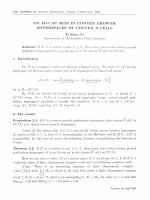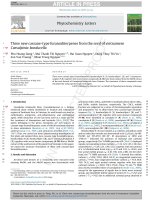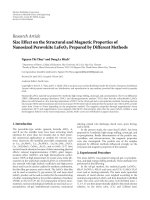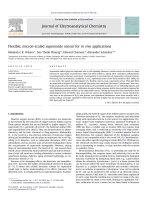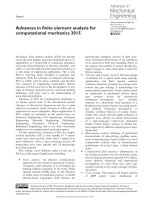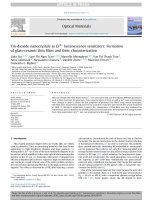DSpace at VNU: Innovative WiMAX broadband internet access for rural areas of Vietnam using TV broadcasting ultra-high frequency (UHF) bands
Bạn đang xem bản rút gọn của tài liệu. Xem và tải ngay bản đầy đủ của tài liệu tại đây (1 MB, 4 trang )
Innovative WiMAX Broadband Internet Access for Rural Areas of Vietnam
using TV Broadcasting Ultra-High Frequency (UHF) Bands
a
Tan T. Duca, Tuyen T. Duca., Dung D. Dob, Hoang V. Nguyenb
University of Engineering and Technology, Vietnam National University, Hanoi, Vietnam
b
Bac Ha International University, Vietnam
presents our implementation methodology. Simulation
results to demonstrate the efficiency of our method and
verifications are presented in Section 4 and 5. Section 6
concludes the paper with discussions on the results and
remarks for future work.
Abstract—This paper presents a case study of the proposed
digital television based WiMAX wireless network to provide
broadband Internet service in the suburban/rural area of
BacNinh province, Vietnam. Advantages of the combination
between digital television and WiMAX in the UHF
broadcasting bands are discussed and compared with existing
WiMAX in the microwave frequency bands. Commercially
available equipments for both base-station and subscriber
station are evaluated and incorporated in the link budget study
and simulation.
II. BRIEF BACKGROUND DIGITAL TELEVISION BASED
WIMAX AND COMPARISON WITH EXISTING WIMAX
Fig. 1 shows the proposed digital television based
WiMAX wireless network. In essence, it is a combination of
one-way traffic digital television broadcasting with two-way
traffic WiMAX Internet/IP data stream. Both technologies
operate in UHF bands and are broadcasted over-the-air from
a single TV tower to many customers within the tower’s
coverage cell. The customer premise equipment typically
consists of an outdoor VHF/UHF antenna, a digital
transceiver terminal having outputs for television and data
stream signals, and a personal computer.
Key words – Broadcasting, digital television, light of site
(LOS), outdoor propagation, WiMAX, UHF.
I. INTRODUCTION
In Vietnam and some other countries in the Asia-Pacific
region, there is a wide digital divine between the urban cities
and the suburban/rural areas. Low income and high illiteracy
coupled with limited access to information technology in
these rural communities are three of the main reasons for the
current digital divine gap. The situation gets even worse in
areas which have a low population density and have an
elevated terrain profile of high hills or mountains. This is
because conventional access such as Asymmetric Digital
Subscriber Line (ADSL) is physically difficult to deploy.
Recent advance in broadband wireless technologies such
as Worldwide Interoperability for Microwave Access
(WiMAX) [1], Long-Term Evolution (LTE) [2] and
Wireless Regional Area Networks (WRANs) [3] promises a
potential solution to bridge this digital divine gap. However,
high
licensed/deployment
costs
(in
the
case
ofWiMAX/LTE) and/or technical obstacles (in the case of
WRAN) still keep these promising technologies either
operated in developed regions with dense population or
being tested in field-trials. The current switching from
analog television (TV) to digital TV in many places around
the world has freed-up a large portion of Ultra High
Frequency (UHF) band, which, as expected, make it a
suitable frequency range for broadband wireless access [4],
[5]. Moreover, the superior propagation characteristic of
UHF signals results in a larger coverage cell for a single
base station transmitter. Essentially, there is less required
base station for a given coverage area and hence lower
deployment cost.
In this study, we are investigating the feasibility of a
digital television based WiMAX wireless network operating
in UHF broadcasting bands in the BacNinh province,
Vietnam. The proposed approach is expected to provide an
economical and sustainable broadband Internet service to
the suburban/rural communities in Vietnam or other
countries facing similar digital divine challenge.
The paper is organized as follows. In Section 2, we
introduce the brief background digital television based
WiMAX and comparison with existing WiMAX. Section 3
978-1-4577-0255-6/11/$26.00 ©2011 IEEE
Fig. 1. Proposed digital television based WiMAX network using ultra high
frequency (UHF) broadcasting bands to provide data service in
suburban/rural area of Bac Ninh, Vietnam.
The WiMAX system in the proposed network operates in
UHF bands where digital television channels do not exist
within the coverage region and therefore will not cause any
harmful interference with existing digital television
channels. Since the two technologies (DVB-T and WiMAX)
have many common factors as can be seen in Tab. 1, its
combination can potentially provide an economical and
sustainable network by sharing tower, transmitting antenna,
and digital modulator/transmitter/amplifier for the downlink
traffic. For uplink traffic, Digital Video BroadcastingReturn Channel Terrestrial can be used to complete the
communication link.
526
TENCON 2011
TABLE I.
DIGITAL VIDEO BROADCASTING - TERRESTRIAL (DVB-T)
AND WIMAX KEY RF CHARACTERISTIC COMPARISON.
Items
Frequency band with
commercially available
equipment
RF PHY
DVB-T
174 - 230 MHz
470 - 862 MHz
WiMAX
450-700 MHz (next BWA) [6]
2300 - 2500 MHz
3600 MHz
OFDM
OFDM
64QAM,
16QAM
QPSK
6, 7, 8 MHz
None
Modulation
Channel BW
Adaptive
Current national spectrum allocation indicates the UHF
bands between 410-470 MHz are currently serviced for
fixed and land mobile communication with a specific band
of 450-470 MHz is used for narrow-band 64, 128 and 384kbps microwave systems [7]. Moreover, there is no existing
digital television channel within the UHF bands from 410470 MHz.
64QAM, 16QAM, QPSK,
BPSK
IV. STUDY CASE IN BACNINH, VIETNAM
3.5, 5, 6, 7, 10 MHz
yes
Fig. 2 shows the terrain map of Bac Ninh province and
neighboring provinces in the northern part of Vietnam with
a zoom-in of our study area within the city of Bac Ninh. The
base station (BS) antenna is located at the Bac Ninh
telecommunications center and three subscriber station (SS)
antennas are located at points Rxi, i=1, 2, and 3 and within 2
km radius to the base station as shown in Fig. 2. The BS
antenna can be placed between 30 m to 60 m height, while
SS antenna is placed at 10.5 m height.
It is well known that low UHF signal has a superior
propagation characteristic compared with high UHF and
microwave frequency signals. As a result, WiMAX system
operating in low UHF bands has a longer reach and larger
coverage area than current WiMAX at 2.5 or 3.5 GHz for
the same transmitting power. With a lower path loss, better
coverage and low cost and simple deployment advantages,
digital television based WiMAX network operating in low
UHF bands provide a compliment to 2.5 or 3.5 GHz
networks in the suburban/rural regions.
A. Propagation Path Loss
For the above BS and SS antenna heights and operating
frequency in the 410-470 MHz UHF band, the Hata
propagation model is selected to compute the propagation
path loss for LOS condition [8]. Since the study area is a
mixture of suburban and rural areas, both suburban and rural
Hata models are selected for comparison. Fig. 3 shows the
computed path loss versus the cell radius from the BS
antenna. Within a 2 km cell radius, the loss varies between
−96 dB and −118 dB for the Hata rural and suburban
models, respectively.
III. IMPLEMENTATION METHODOLOGY
To validate and to test the network, we first conduct a
throughout survey of commercially available WiMAX
equipments operated in the UHF bands. Next, a system
study and frequency assessment are performed to select a
center operating frequency, bandwidth, power for the
system.
A. Commercial WiMAX Equipment in the UHF bands
B. Link Budget
At the current time, Harris Stratex Networks is the only
supplier that provides both base station and subscriber
station WiMAX equipment in the low UHF bands. The base
station and subscriber station models are HSX StarMAX
6000 and HSX StarMAX 2160, respectively [6]. Tab. 2
summarizes the key RF specifications of the equipment,
which will be later used in the link budget calculation. Both
models support time division duplexing which is a more
suitable for asymmetrical traffic commonly found in
WiMAX network.
Table 3 summarizes the parameters used at the BS
transmitting antenna and SS receiving antenna for the link
budget calculation. Maximum power is first selected to
study the effective link reliability at the 2 km radius and
maximum achievable distance for a 90% link reliability for
both uplink and downlink traffics for QPSK modulation.
Table 4 shows the results for two BS antenna height of 30
m and 60 m. The excess link surplus indicates that transmit
power can be reduced or higher bit rate (higher modulation
such as 16QAM or 64QAM) can be accommodated.
TABLE II.
KEY RF SPECIFICATIONS FOR COMMERCIALLY AVAILABLE
BASE STATION (BS) AND SUBSCRIBER STATION (SS) WIMAX EQUIPMENT
AT UHF BANDS
Items
Frequency
RChannel BW
Tx Power
Rx Sensitivity
Modulation
Duplex Method
Base station
410 - 470 MHz
1.75, 2.5, 3 MHz
3.5, 5, 6, 7 MHz
+42 dBm
-95 dBm
@ 5MHz BPSK
64QAM,
16QAM
QPSK, BPSK
TDD
TABLE III.
PARAMETERS USED IN THE LINK BUDGET ANALYSIS
Base station
(Downlink)
42 dBm
8 dB
-95 dBm
18 dBi
1.5 Mbps
QPSK
90 %
Items
Subscriber station
410 - 470 MHz
1.75, 2.5, 3 MHz
3.5, 5, 6, 7 MHz
+30 dBm
-95 dBm
Transmit Power
NF
Sensitivity
Antenna gain
Capacity
Modulation
Reliability margin
@ 5MHz BPSK
64QAM, 16QAM
QPSK, BPSK
TABLE IV.
TDD
Subscriber station
(Uplink)
30 dBm
6 dB
-90 dBm
12 dBi
0.3 Mbps
QPSK
90 %
LINK BUDGET RESULTS
Items
B. Commercial WiMAX Equipment in the UHF bands
1
hTX
= 30km
Our current site survey indicates that a line-of-site (LOS)
or near LOS condition is satisfied in the coverage region in
Bac Ninh province, Vietnam and a cumulative bandwidth of
approximately 1.8 megabits per second (Mbps) (1.5Mbps
for downlink and 0.3Mbps for uplink traffics) is required.
Reliability @ 2km
Maximum cell radius for 90% link
Link surplus @ 2km
Downlink
Uplink
100%
30km
41.5 dB
100%
30km
29.5 km
100%
100%
1
hTX
= 60km
Reliability @ 2km
527
Maximum cell radius for 90% link
Link surplus @ 2km
49.33 km
46.3 dB
communication systems. It provides efficient and accurate
predictions of propagation and communication channel
characteristics in complex urban, indoor, rural and mixed
path environments [9].
The virtual building and terrain environment is either
constructed using Wireless InSite’s editing tools or imported
from a number of popular formats. More than 1000 building
has been imported using Wireless Insite’s editing tool (see
Fig. 5). The terrain file of BacNinh province is available
from the Shuttle Rada Topography Mission [10]. The study
area is between 210 and 21015′ North and 105055′ and
106015′ East. The study area is next populated with actual
buildings, landscapes, transmitting and receiving stations
with specifications given in the above tables. Fig. 5 shows
the radio frequency power distribution in the study area with
a single transmitting antenna mounted on a BS tower located
at 21011′29.5” North and 10604′40.2” East.
30.38 km
39.3 km
Fig. 2. Terrain map of Bac Ninh province and neighboring provinces with a
zoom-in of the study area in the city of Bac Ninh.
Fig. 4. The virtual building of more 1000 highest building in BacNinh
Fig. 5. The radio frequency power distribution in the study area with a
single transmitting antenna
Wireless InSite makes these calculations by shooting rays
from the transmitters, and propagating them through the
defined environment. These rays interact with
environmental features and make their way to receivers.
Fig. 6 shows the simulation result of the propagation rays
between a single transmitter (106.067 longitude, 21.1801
latitude at 450MHz, BW = 5 MHz, P=42 dBm) and a single
receiver (106.067 longitude, 21.1801 latitude) using the
directional antennas. The effects of each interaction along a
ray’s path to the receiver are evaluated to determine the
resulting signal level. At each receiver location, rays are
combined and evaluated to determine signal characteristics
such as path loss, delay, direction of arrival, and impulse
response.
Fig. 3. Propagation path loss for UHF signal at 450 MHz frequency using
sub-urban and rural Hata models for two different base station transmiting
antenna height,
height is
1
2
hTX
= 30 m and hTX
= 60 m. The receiving antenna
hRX = 10.5 m
V. THEORETICAL VERIFICATION
A. Software Package
The network operation is verified using Remcom
Wireless Insite which is site-specific radio propagation
software for the analysis and design of wireless
528
REFERENCES
[1]
Jeffrey G. Andrews, Arunabha Ghosh, and Rias Muhamed,
Fundamentals of WiMAX: Understanding broadband wireless
networking, Prentice Hall, 2007.
[2] Ekstrom, H., el. at., Technical solutions for the 3G long-term
evolution, IEEE communication magazine, Vol. 33 (3), 2006, pp. 3845.
[3] Stevenson C., Chouinard G., Zhongding Lei, Wendong Hu,
Shellhammer S., Caldwell W., The IEEE 802.22: the first cognitive
regional area network standard, IEEE communications magazine, Vol.
47(1), 2009, pp. 130-138.
[4] M. Nishi, Y. Atsumi, T. Toyota, and T. Yoshida, ”Proposal of new
information traffic platforms in UHF band for communication and
broad-casting services” in Global Telecommunications Conf GLOBECOM’01, San Antonio, TX, USA, Nov. 2001, pp. 552 - 556.
[5] Honcharenko W., Kruys J.P., Lee D.Y., Shah N.J., Broadband
wireless access, IEEE Communication Magazines, Vol. 35(1), 1997,
pp. 20-26.
[6] />[7] Radio frequency channel arrangement for Fixed and Mobile services
30- 1000MHz, .
[8] T. S. Rappaport, Wireless Communications: Principles and Practice,
Prentice Hall, 2002.
[9] The Wireless Insite user’s manual, />[10] The Shuttle Radar Topography Mission, Rev. Geophysics, 45,
RG2004, doi: 10.1029/2005RG000183.
Fig. 6. Rays reaching receiver are reflected off and/or transmitted though
buildings.
B. Simulation Results
Tables 5 and 6 summarize the simulation results of the
maximum coverage area per BS and the number of required
BS to provide a complete coverage in the study area. In
table 5, the antennas are directional antenna with 18 dBi and
Yagi antenna with 12 dBi for BS and SS respectively. On
the other hand, the antennas are isotropic antennas at both
BS and SS in table 6. As can be seen, the number of BS is
always lower than that of conventional WiMAX system
operating at 2.5 GHz and 3.5 GHz. As a result, the proposed
system will have a lower overall deployment and operating
costs.
TABLE V.
REMCOM WIRELESS INSITE RESULT COMPARING
MAXIMUM DISTANCE AND COVERAGE FOR WIMAX AT 450 MHZ, 2.5 GHZ,
AND 3.5 GHZ USING DIRECTIONAL ANTENNA IN BS AND SS.
Items
Maximum distance (km)
Coverage area (km2)
Required number of BS
450 MHz
36.92
52700
2
2.5 GHz
10.24
1124
8
3.5 GHz
7.01
360
17
TABLE VI.
REMCOM WIRELESS INSITE RESULT COMPARING
MAXIMUM DISTANCE AND COVERAGE FOR WIMAX AT 450 MHZ, 2.5 GHZ,
AND 3.5 GHZ USING ISOTROPIC ANTENNA IN BS AND SS.
Items
Maximum distance (km)
Coverage area (km2)
Required number of BS
450 MHz
6.44
837
7
2.5 GHz
1.68
11
95
3.5 GHz
1.21
5.6
147
VI. CONCLUSION
This work investigates a practical implementation of a
DTV based WiMAX network to provide a potential low cost
and sustainable broadband services to the suburban/rural
areas in Vietnam. The study outlines the advantages of the
combination of the two technologies and selects commercial
available WiMAX equipments for the field-trials.
Simulation results based on Wireless Insite software have
shown the ability to apply to real applications. In the future,
measurements will be carried out to verify the simulated
results.
ACKNOWLEDGMENT
This research was supported bilaterally by TRIG-B
project and NAFOSTED fund.
529
